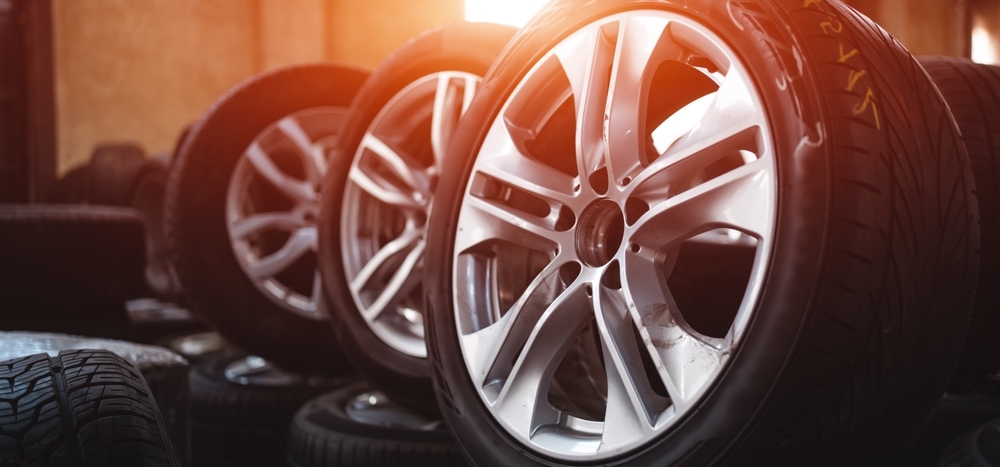
30 May Auto Tires | Auto Stability Triangle Part 4
 In this 4-part blog series, we have explored how auto maintenance applies to the safety and performance of our vehicles. The suspension, wheel alignment, and auto tires comprise the three parts of the auto stability triangle. In this final installment, I will show how vital auto tire maintenance is for vehicle safety. I will explain tread depth, tire pressure, and tire balancing. Additionally, we will look at common tire issues and the warning signs you may experience. Finally, we‘ll see how tires can impact your vehicle’s suspension & alignment and how to address those concerns.
In this 4-part blog series, we have explored how auto maintenance applies to the safety and performance of our vehicles. The suspension, wheel alignment, and auto tires comprise the three parts of the auto stability triangle. In this final installment, I will show how vital auto tire maintenance is for vehicle safety. I will explain tread depth, tire pressure, and tire balancing. Additionally, we will look at common tire issues and the warning signs you may experience. Finally, we‘ll see how tires can impact your vehicle’s suspension & alignment and how to address those concerns.
How Auto Tires Affect Auto Stability
Your vehicle’s tires are the first point of contact with the road. Auto stability is negatively impacted when there is a loss of traction. If there are issues with your vehicle’s tires, you may experience a loss of traction and handling, resulting in greater stress on your auto’s suspension system. As you can see, all three parts of the auto stability triangle impact each other.
Tires: Maintenance & Safety
When it comes to tires, routine maintenance is vital to achieving safety for your vehicle and your passengers. Like Benjamin Franklin said, “an ounce of prevention is worth a pound of cure.” You can greatly reduce the chance of blow-outs and other tire-related accidents by maintaining your tires correctly. Therefore, let’s look at a few basics of tire maintenance:
Tread Depth
The tread is the rubber on the tire that touches the road. New tires generally have an average tread depth of 8 – 9 mm (10/32 – 11/32 in). When you drive, the tread naturally wears down. In a perfect world, the tread wears evenly across the entire tire. Regular tire maintenance (including tire rotation, wheel balancing, and alignment) helps regulate tire tread wear.
Tire Pressure
Maintaining the correct tire pressure has many benefits for your vehicle. It helps ensure that tires wear more evenly and provides a more comfortable ride. It may also increase your fuel efficiency and reduce tire tread wear by up to 50% over the lifetime of your tire. The tire pressure should match the psi (pounds per square inch) listed in your owner’s manual or on the decal inside the driver’s door jam. The recommended psi may differ on the front and rear tires, so check carefully.
Tire Balancing
This may surprise some of you, but tires and wheels are not perfectly round. Slight imperfections in manufacturing the metal wheel and rubber tire are normal. These imperfections cause an uneven distribution of weight. A qualified technician can perform minor adjustments with a highly calibrated balancer and wheel weights. This process will enable your tire and wheel to rotate together evenly. Once your tires are balanced, you will enjoy a smoother ride and reduce wear on suspension components.
Tires: Issues & Warning Signs
Tire Age
Tires are made from many materials, including natural and synthetic rubbers. Over time, these rubber products break down and become unreliable. Most auto manufacturers now recommend replacing tires every 6 years, regardless of tire tread wear. Tire age and tire safety should be considered carefully. Old tires can be dangerous. If your vehicle’s tires are approaching 6 years of age, have them inspected by a professional tire expert. If it has been 10 years since you replaced your tires, make an appointment asap to get them replaced. And don’t forget your spare!
Worn Tread
If you rack up a lot of miles on your tires because of a long work commute or frequent weekend getaways, you may have worn tread on your tires. Worn tread can contribute to less traction and reduced braking, especially in wet weather. If your automobile takes longer to stop or seems to lose traction, bring it in for a tire inspection at your local service center.
Tire Damage
A quick visual inspection of your wheels and tires can be done each time you fill up your gas tank. Simply walk around your vehicle and look at each tire carefully. Do you notice any bulges, bubbles, or bald spots on the tire? Are there cracks, missing chunks, or other damage to the sidewall or tread? Make sure the tire is not under-inflated or over-inflated. If you notice any irregularities in your tire or rim, immediately bring it in for service. Blow-outs, flats, and slow leaks can cause accidents and collisions that are easily preventable with proper tire maintenance.
Vibrating Steering Wheel
A vibrating steering wheel while driving at higher speeds can indicate unbalanced wheels. You may also notice it worsens as you go faster, and you may experience vibrations on the floor and feel it through your seat. Have a technician inspect your vehicle for wheel balancing issues.
Auto Tires: Inspection Tips
Tires are one of the more simple vehicle maintenance items on our vehicle. Most people can check their tire pressure and visually examine their tires. Use these tire inspection tips to help keep your vehicle’s tires in top condition.
- Do weekly visual inspections on your tires, tread, and rims.
- Check your tire pressure at least 2 times per month using a quality digital gauge.
- Use a Tread Depth Indicator tool to test the tread depth on your tires. Be sure to check the entire circumference of each tire (not just in one place). Replace your tires immediately if they read 1/16 inch (0.16 cm) or lower, as they are unsafe and may even be illegal.
- Keep your tires clean. Wash your vehicle monthly to remove road grime, de-icing chemicals, and oils. Clean and condition your tires with products designed specifically for them.
- Replace worn, damaged, or old tires in a timely manner.
Schedule Auto Tires Service in Plymouth Meeting, PA
Plymouth Auto & Tire Center has partnered with www.tirerack.com. All major brands and models are available. Request a tire quote or schedule a tire service online. You can also call us at (610) 825-6558 for more information on purchasing new tires and discussing all the tire services we provide.
Previous Blogs in Series
Auto Stability Triangle Part 1 | Overview

